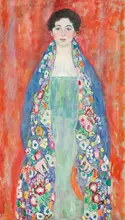Portrét Fräulein Lieser
Date:
1917Medium:
oil on canvasDimensions:
80 x 140The three-quarter painting portrays a young woman facing forward, set against a red background. She wears a cloak adorned with flowers around her shoulders, reflecting Klimt's typical later color scheme.
Believed to depict a member of the Lieser family, Viennese industrialists, the subject may be a daughter of Justus and Henriette Lieser, based on information from the auction house. Visiting Klimt's studio multiple times between April and May 1917, the subject posed for the painting.
Measuring 140 by 80 centimeters, the painting's background contains faint pencil outlines, indicating Klimt's intentions for further elaboration.
Originating in 1917, Klimt left the Portrait of Fräulein Lieser unsigned in his studio upon his death in 1918, later passing it to the family. After being exhibited in Vienna's Neue Galerie in 1925, the painting entered a private collection with only a black-and-white photograph documenting its existence. It was believed to have been owned by either Adolf or Henriette Lieser.
Following Austria's merger with Nazi Germany in 1938, the Lieser family faced persecution under anti-Jewish laws, resulting in the confiscation of their assets and homes. Henriette "Lilly" Lieser was deported to Riga in 1942 and died there in 1943.
Around 1960, the portrait was acquired and eventually came into the possession of an anonymous Austrian citizen. Rediscovered in 2024 after the owner approached an auction house, the painting's whereabouts between 1925 and 1960 remain unknown.
Klimt painted picture Portrét Fräulein Lieser in 1917. Prevailing color of this fine art print is red and its shape is portrait. Original size is 80 x 140. This image is printed on demand - you can choose material, size and finishing.
Gustav Klimt (1862-1918). As a painter, Klimt represents the best period of Vienna – a time when the works of Sigmund Freud or Mahler were developing, and Vienna was at the very least the Central European centre of culture and education. Klimt’s work combines
symbolism and Byzantine features that create the undertone of his Art Nouveau style. Klimt’s images have a special, even anxious, atmosphere that often shows the Freudian idea of erotica in any human movement and action. Klimt paints two-dimensionally, with intense colour while at the same time very gently and with refined dignity. Among Klimt’s famous works are the
Water Snakes - two women with stylized, interwoven bodies that evoke the surreal world of fantasy and sensuality. Another masterpiece is
Danae, a work inspired by Greek mythology, depicting a girl seized by Zeus, who was turned into a golden rain (Danae later gave birth to Perseus). His paintings often aroused passions and public protests, not only for their content but also for the innovative painting methods - eg.
The Girlfriends, an image of two women at a romantic meeting.


